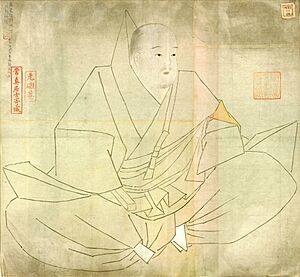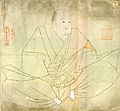Emperor Shirakawa facts for kids
Quick facts for kids Emperor Shirakawa白河天皇 |
|||||
|---|---|---|---|---|---|
 |
|||||
| Emperor of Japan | |||||
| Reign | 18 January 1073 – 3 January 1087 | ||||
| Coronation | 8 February 1073 | ||||
| Predecessor | Go-Sanjō | ||||
| Successor | Horikawa | ||||
| Born | 7 July 1053 | ||||
| Died | 24 July 1129 (aged 76) | ||||
| Burial | Jōbodai-in no misasagi (成菩提院陵) (Kyoto) | ||||
| Spouse | Fujiwara no Kenshi | ||||
| Issue more... |
|
||||
|
|||||
| House | Yamato | ||||
| Father | Emperor Go-Sanjō | ||||
| Mother | Fujiwara Shigeko | ||||
Emperor Shirakawa (白河天皇, Shirakawa-tennō, 7 July 1053 – 24 July 1129) was the 72nd emperor of Japan. He ruled from 1073 to 1087.
Emperor Shirakawa is famous for starting a new way of ruling. This was called cloistered rule. It meant that even after he officially stepped down, he still had a lot of power. He guided the emperors who came after him for many years.
Contents
Family Life
Before becoming emperor, his personal name was Sadahito.
He was the oldest son of Emperor Go-Sanjō and Fujiwara Shigeko.
Shirakawa had one main Empress and several children.
- Empress (chūgū): Fujiwara no Kenshi
- First Son: Imperial Prince Atsufumi (1075–1077)
- First Daughter: Imperial Princess Yasuko
- Third Daughter: Imperial Princess Reishi
- Third Son: Imperial Prince Taruhito, who later became Emperor Horikawa
- Fourth Daughter: Imperial Princess Shinshi (1081–1156)
Key Moments in Shirakawa's Reign
Emperor Shirakawa was the first emperor to officially retire to a monastery. However, he continued to have a lot of power over the next emperors. This way of ruling became known as cloistered rule.
When he was young, his relationship with his father was not always easy. But in 1068, when his father became emperor, Sadahito was named an Imperial Prince. In 1069, he became the Crown Prince. He became emperor at age 19.
- January 18, 1073: Emperor Go-Sanjō stepped down. His son, Sadahito, became the new emperor. He was then known as Emperor Shirakawa.
Shirakawa wanted to rule directly, like his father. He tried to control the shōen (manor) system. This was to reduce the power of powerful families like the Fujiwara.
- 1074: A former chief advisor, Fujiwara Yorimichi, passed away at 83.
- 1077: Shirakawa visited important Kamo Shrines and Buddhist temples like Kiyomizu-dera.
- 1077: The emperor ordered the building of Hosshō-ji temple. This was a very grand temple with a nine-story pagoda. It was the first of many "sacred vow" temples he would build.
- 1081: The Buddhist Temple of Miidera was burned down by monks from a rival group on Mt. Hiei. It was burned again later that year.
- 1084: His main empress, Kenshi, died. Shirakawa was very sad and let his ministers handle the government for a while.
- 1087: Shirakawa announced he would step down. He wanted his son to become the next emperor.
- January 3, 1087: Shirakawa officially gave up the throne. He took the title Daijō-tennō, which means "retired emperor." He had been emperor for 14 years. For the next 43 years, he would rule from behind the scenes. This was the start of cloistered rule.
Shirakawa's father had wanted his younger half-brother to be the next emperor. But in 1085, this half-brother died. So, Shirakawa's own son, Taruhito, became the Crown Prince.
On the same day Taruhito was named his heir, Shirakawa stepped down. Taruhito became Emperor Horikawa. The retired Emperor Shirakawa then ruled indirectly from his palace, the Shirakawa-in.
- 1087: Retired Emperor Shirakawa moved to Uji.
- 1088: Shirakawa visited the temples on Mt. Hiei.
- 1095: Buddhist priests from Mt. Hiei came down from their mountain to protest a dispute. They even brought a portable shrine.
- 1096: Former-Emperor Shirakawa became a Buddhist monk at age 44. He took the name Yūkan. When a retired emperor becomes a monk, he is called a hō-ō.
After Emperor Horikawa died, Shirakawa's grandson became Emperor Toba. Shirakawa was still alive when Toba also stepped down for his son, who became Emperor Sutoku. By the time Shirakawa died in 1129, he had been a cloistered Emperor for 41 years. During this time, three emperors ruled, but Shirakawa was the real power behind them.
His name, Shirakawa, comes from Shirakawa-in, the name of the place where he lived and ruled after stepping down.
Important Officials During Shirakawa's Time
Kugyō was a special name for the most powerful men in the emperor's court. Even when the emperor's direct power was small, these officials were very important.
This group usually had only a few men at a time. They were experienced courtiers who had reached the highest levels of government. During Shirakawa's reign, some of these top officials included:
- Kampaku, Fujiwara Morozane
- Sadaijin, Fujiwara Morozane
- Nadaijin, Fujiwara Moromichi
Eras During Shirakawa's Rule
The years of Shirakawa's rule are divided into different era names or nengō.
Images for kids
See also
- Emperor of Japan
- List of Emperors of Japan
- Imperial cult
- Emperor Go-Shirakawa
| Regnal titles | ||
|---|---|---|
| Preceded by Emperor Go-Sanjō |
Emperor of Japan: Shirakawa 1073–1087 |
Succeeded by Emperor Horikawa |


